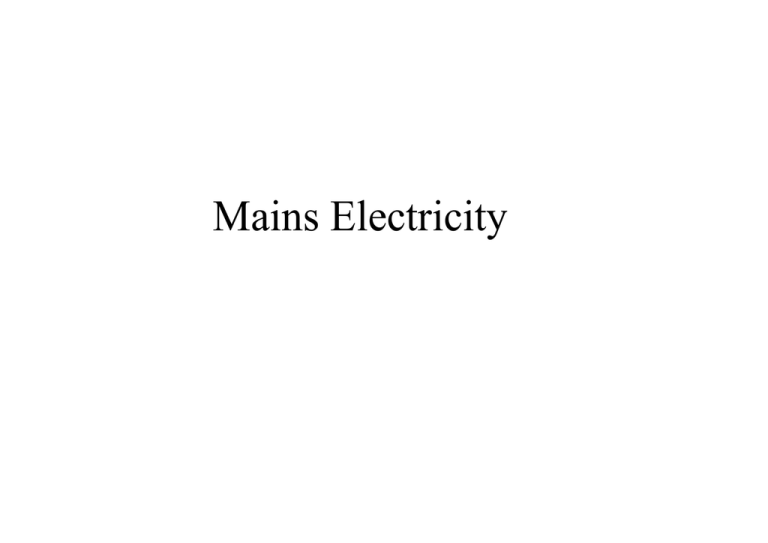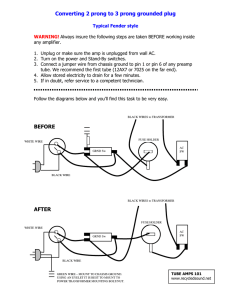Mains Electricity - St Mary`s College
advertisement

Mains Electricity Mains electricity is an alternating current (A.C.) power supply (ac) Direct Current (d.c.) one direction only Alternating Current (a.c.) constantly changing direction load load (circuit components) (circuit components) Mains electricity has a frequency of 50Hz; 50 complete waves per second: Here the current is flowing one way around the circuit ...and here it is flowing the other way around the circuit Power station Live Neutral step up transformer The National Grid step down transformer earth connection Live Neutral The live wire at your house is kept at 230V and the neutral wire is earthed (connected to the ground) to force it to be 0V step down transformer earth connection Power station Live Neutral step up transformer step down transformer earth connection Live Neutral The live wire at your house is kept at 230V and the neutral wire is earthed (connected to the ground) to force it to be 0V step down transformer earth connection Mains electricity in the home fuse box live wire neutral wire ring mains There is no circuit until you connect an electrical device between the live and neutral rings Connecting to the ring mains M motor !! z zz live wire Bzz neutral wire Each device is connected to the ring mains in parallel. This means that: • they can be switched on/off individually • if one fails it doesn't stop the rest from working • you can connect as many devices as you have wall sockets Don't worry about the earth wire yet earth wire sTriped live wire (230V) bRown The live & neutral must be correctly connected to make a complete circuit and operate the device neutral wire (0V) bLue The cable grip must grip the main cable not the individual wires The earth wire is only needed to protect the user against electrocution ­ the device will work even if it is not connected The earth wire should be excessively long so that it pulls out of the plug last The Earth Wire This wire also goes around the room with the ring mains and is connected to the ground by a large copper pipe l bo m sy Dangerous currents can be carried down into the ground through the grounding rod ac tu al ground rod installation Normal operation Complete circuit via power supply metal case live wire heating element insulator neutral wire Live wire touches the element case which touches the metal case Faulty live wire neutral wire Live wire touches the case Current flows from the 230V person down to the 0V ground (current flows from high voltage to low) The current flows through the earth wire instead of the person because the person has a much higher resistance My kettle doesn't work! The metal case is live (connected to the live wire/at 230V)... live wire h e Hig istanc res neutral wire ...but the current flows down into the ground through the earth wire negligible resistance The Fuse This is a thin piece of wire with a low melting point. Electric currents produce heat. If the current gets too big, the fuse melts which breaks the circuit. Live metal case Load (eg a heating element) Neutral insulation The load has a high resistance which opposes the current and brings it down to a safe value fuse Live metal case Load (eg a heating element) Neutral This circuit now goes: Live insulation The fuse is put in the live wire because the live wire is the dangerous one. When the fuse "blows" (melts) the live wire is disconnected a.c. metal case a.c. neutral The metal case has a much lower resistance than the load, so the current shoots up. This melts the fuse wire and breaks the circuit. Choosing a fuse The fuse must be safe at the the operating current of the device it protects, but must "blow" at a lower current than the device it protects. Eg, a 13A fuse melts at 13A. It can protect a computer that runs at 10A but blows at 15A. A 23A fuse would be useless as the computer would "blow" to protect the fuse! Circuit Breakers Power spring pushing supply plunger to the right iron bolt spr spring pushing iron bolt upwards ing Reset button plunger Load These are electromagnetic switches that open when the current is too high. As the current increases the electromagnet increases in strength and pulls the iron bolt down. This allows the plunger to spring to the right which opens the switch. The switch is reset by pushing the reset button. Electrical Power Power is the rate of doing work. Work is changing one form of energy into another, so Power = amount of energy transformed time taken because it is a rate Also: Electrical power (in watts, W) = current x potential difference (in A) (in V) Electrical power (in watts, W) = current x potential difference (in A) (in V) A bulb operates at 230V and draws 0.44A of current. What is the bulbs power rating? Power = current x potential difference = 0.44A x 230V = 101.2W P Vx I Electrical power (in watts, W) = current x potential difference (in A) (in V) What current would flow through a normally operating 230V, 500W heater? Power = current x potential difference current = power p.d. = 500W = 2.17A 230V What value fuse should you choose for this heater? 3A 5A 13A Calculating Electrical Charge Potential difference (voltage) causes charge to flow. This flow of charge is the current. Charge is measured in units called coulombs (C) The symbol for charge is Q (just live with it!) Actually, come to think of it, the examiners always use words, not symbols One coulomb is the amount of charge that flows when 1A flows for 1 second. ie, 1 coulomb = 1A x 1second Charge = current x time so charge = current x time Charge, Q = current, I x time, t (in coulombs, C) (in A) (in s) A current of 4A flows for 10s. How much charge flows? Q Ixt Charge = current x time = 4A x 10s = 40C A current of 10A flows for one hour. How much charge flows? One hour = 60 minutes = 60 x 60s = 3600s Charge = current x time = 10A x 3600s = 360,000C Charge, potential difference and energy Heat is produced in a circuit component when charge flows through it. This is because the flowing electrons hit the atoms of the component and give them kinetic energy/heat. The formula Energy = power x time, and power = current x potential difference So, Electrical energy = current x potential difference x time (in J) (in A) (in V) (in s) ...or E = VIt if you prefer (I do, the examiners don't) Electrical energy = current x potential difference x time (in J) (in A) (in V) (in s) How much energy is transferred when a current of 3A flows through a potential difference of 5V for 20s? Energy = current x p.d. x time = 3A x 5V x 20s = 300J





